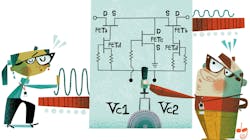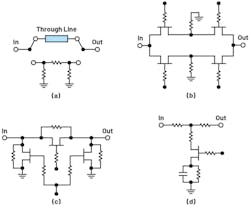RF Demystified: What is an RF Attenuator?
Members can download this article in PDF format.
What you’ll learn:
- There are numerous types of attenuators, including fixed-value, voltage variable, and digital step attenuators.
- Attenuators are available in many design configurations and in three basic topologies.
- In selecting attenuators for a given application, pay attention to the key specifications.
The attenuator is a control component, the main function of which is to reduce the strength of the signal passing through it. This type of component is generally used to balance signal levels in the signal chain, to extend the dynamic range of a system; provide impedance matching; and implement various calibration techniques in the end application design.
Types of Attenuators
From the key functional perspective, attenuators can be classified as fixed attenuators with an unchanging level of attenuation and variable attenuators with an adjustable level of attenuation. Depending on the form of attenuation control supported by variable attenuators, they can in turn be further classified as voltage variable attenuators (VVAs), featuring analog control, and digital step attenuators (DSAs) that are controlled digitally.
VVAs provide continuous adjustment of attenuation levels that can be set to any value within the given range. Analog variable attenuators are usually employed for automatic-gain-control circuits, calibration corrections, and other processing functions where smooth and precise control of a signal is required.
DSAs feature a set of discrete attenuation levels allowing for signal-strength adjustments with a predetermined attenuation step size. Digitally controlled RFIC attenuators offer a control interface compatible with microcontrollers and provide a good solution to maintain functional integrity in complex designs.
Design Configurations
Attenuator ICs can be realized in GaAs, GaN, SiC, or CMOS technologies using resistors, PIN diodes, FETs, HEMTs, and CMOS transistors. Figure 1 shows three basic topologies that underlie various types of attenuator design configurations: T-type, π-type, and bridged-T networks.
Fixed-value attenuators use these core topologies realized with resistors in thin-film and thick-film hybrid technologies to provide fixed levels of attenuation.
VVAs typically use a T-type or π-type configuration with a diode or transistor elements operated in a nonlinear resistance region. The resistance characteristics of the base elements are exploited to adjust the required level of attenuation by varying the control voltage.
DSAs usually employ multiple cascaded units representing individual bits that can be switched in or out to achieve the required level of attenuation. A few configuration examples used for DSA designs are shown in Figure 2.
Configurations include integrated SPDT switches that toggle input and output ports with the attenuating pad and a through line, switched-scaled device designs with transistors or diodes used as switchable resistances, switched-resistor configuration where the resistors can be switched in or out of the circuit, and device-embedded type design with a transistor or a diode as an integral part of the design.
Attenuator topologies can be arranged into a reflection- or balanced-type design (Fig. 3). Reflection-type devices use equal attenuators connected to the output of a 3-dB quadrature coupler and typically offer a large dynamic range. Balanced configurations combine a pair of identical attenuators using two 3-dB quadrature couplers and provide good VSWR and power-handling capability.
In addition to the main design configurations described in this article, other types of circuits are utilized for realization of IC attenuator components; however, their consideration is beyond the scope of this short article.1,2
Key Specifications
To select the right type of an attenuator for the end application, an engineer must have a good understanding of its key specifications. Apart from the attenuation capabilities and some fundamental parameters such as insertion and return loss, other key characteristics are used to describe attenuator components:
- Frequency range (Hz): The frequencies over which the IC maintains its specified characteristics.
- Attenuation (dB): The amount of suppression above and beyond the insertion loss.
- Frequency response: Variation of the attenuation level (dB) across the frequency range (Hz.)
- Attenuation range (dB): The total value of attenuation offered by the component.
- Input linearity (dBm): It’s usually expressed in terms of the third-order intercept point (IP3), defining a hypothetical point for the input power level at which the power of the corresponding spurious components would reach the same level of the fundamental component.
- Power handling (dBm): It’s typically described in terms of the input 1-dB compression point defining the input power level at which the insertion loss of the attenuator decreases by 1 dB; the power-handling characteristic is often specified for the average and peak input power levels for the steady-state and hot-switching modes.
- Relative phase (degrees): A shift in phase introduced to a signal by the attenuator component.
In addition to these common parameters, variable attenuators also are described by their switching characteristics. They’re typically expressed in nanoseconds in terms of rise and fall time, on and off time, and the amplitude and phase settling time of the RF output signal.
There are also specific characteristics inherent to each type of variable attenuators. For VVAs, they’re related to their analog control operation:
- Voltage control range (V): The voltages required to adjust the attenuation level within the attenuation range
- Control characteristics: These are usually expressed in terms of the attenuation slope (dB/V) and the performance curves showing the level of attenuation as a function of control voltage
For DSAs, their inherent characteristics, in turn, include:
- Attenuation accuracy (also known as the state error, dB): The limit of variation in the attenuation level relative to the nominal value
- Attenuation step size (dB): The delta between any two successive attenuation states.
- Step error (dB): The limit of variation in the attenuation step size relative to the nominal value.
- Overshoot and undershoot (dB): The level of signal transients (glitches) during state transitions.
A good attenuator component is generally required to deliver flat attenuation performance and good VSWR across the operational frequency range, to offer sufficient accuracy and power-handling capability, and to ensure smooth glitch-free operation with little signal distortion during state transitions or to provide linear control characteristic.
Conclusion
The broad diversity of IC attenuator components certainly isn’t limited to only those discussed in this article. We can recognize other types of ICs, including frequency-dependent and phase-compensated attenuators, temperature variable attenuators, programmable VVAs with an integrated digital-to-analog converter (DAC), and others.
However, in this article, we considered the most common categories of IC attenuators and discussed their main topologies and key specifications, which can help an RF designer to choose the right component for an end application.
References
1. Inder J. Bahl. Control Components Using Si, GaAs, and GaN Technologies, Artech House, 2014.
2. Ian Robertson and Stepan Lucyszyn. RFIC and MMIC Design and Technology, The Institution of Engineering and Technology, November 2001.
About the Author
Anton Patyuchenko
Field Applications Engineer
Anton Patyuchenko received his Master of Science in microwave engineering from the Technical University of Munich in 2007. Following his graduation, Anton worked as a scientist at German Aerospace Center (DLR). He joined Analog Devices as a field applications engineer in 2015 and is currently providing field applications support to strategic and key customers of ADI specializing in RF applications.



